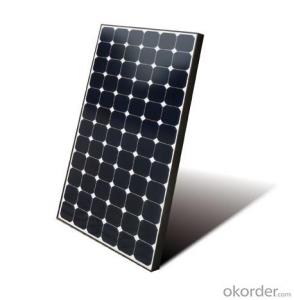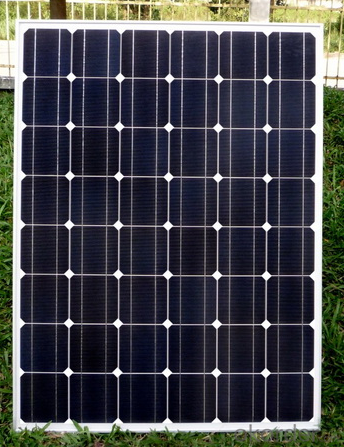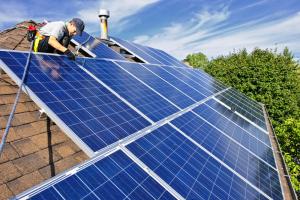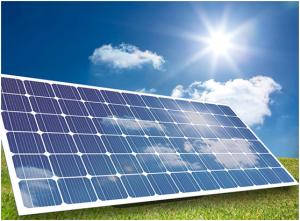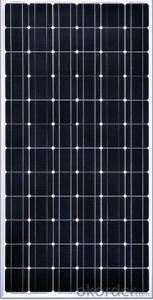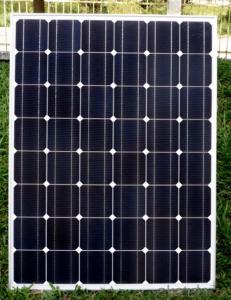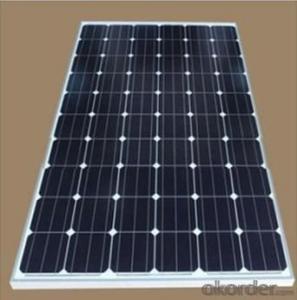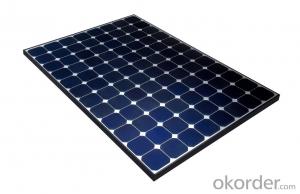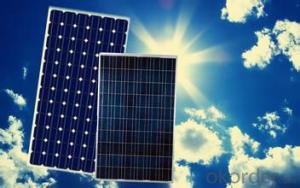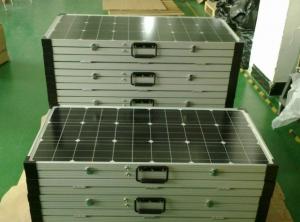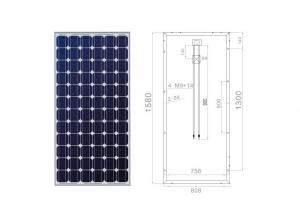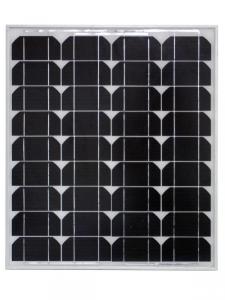10w CNBM Polycrystalline Silicon Solar Panel for Home Using - LG Solar Panels UK
- Loading Port:
- Shanghai
- Payment Terms:
- TT OR LC
- Min Order Qty:
- 100 watt
- Supply Capability:
- 1000 watt/month
OKorder Service Pledge
OKorder Financial Service
You Might Also Like
Specification
10W CNBM Polycrystalline Silicon Panel for Home Using
Production description
close-packed rectangular multi-junction (MJ) cells are preferably used in solar panels on spacecraft, as they offer the highest ratio of generated power per kilogram lifted into space. MJ-cells are compound semiconductors and made of gallium arsenide (GaAs) and other semiconductor materials. Another emerging PV technology using MJ-cells is concentrator photovoltaics (CPV).
A photovoltaic (in short PV) module is a packaged, connected assembly of typically 6×10 solar cells. Solar PV panels constitute the solar array of a photovoltaic system that generates and supplies solar electricity in commercial and residential applications. Each module is rated by its DC output power under standard test conditions, and typically ranges from 100 to 365 watts.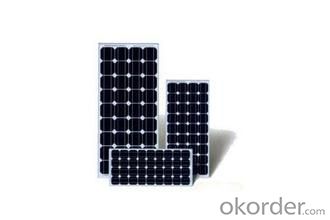
Feature
1.High conversion efficiencies resulting in superior power output performance.
2.Outstanding power output even in low light or high temperature conditions
3.Optimized design for ease of soldering and lamination
Physical characteristic
1. Rigorous quality control meets the highest international standards.
2. High-transmissivity low-iron tempered glass, strong aluminium frame.
3. Using UV-resistant silicon.
4. IS09001/14001/CE/TUV/UL
packaging
26 pcs in one palllets, 24pcs in one boxs
- Q: I'm a carpenter, and can do electric work. I want to make some money installing Solar Panels. what's the best source?
- only when you consider which you have a image voltaic panel, it does not recommend you would be getting a examine from the applying enterprise. A image voltaic equipment could be set up so as that it runs off the grid wherein case you will no longer see a pink cent from the applying enterprise OR this is set as much as run on the area of with the grid means, which usually supply means via day and you reside off the grid via evening. is a few situations you will get money from the applying enterprise yet provided that your generating greater electrical energy than you employ and provided that the equipment is desperate as much as supply regulated 0VAC means.
- Q: i was looking into making solar panels to reduce my electric bill, but i need to know how to actually hook it up.
- nowing what to do with unused renewable electricity is always a dilemma – hooking up to the grid has to be the preferred option. If your residential home is grid tied, i.e. connected the electricity grid as opposed to off-grid and you are using solar panels to generate electricity. Then it makes a lot of sense to hook your solar panels to the grid, because instead of losing the unused electricity or having to maintain a bank of deep cycle batteries, you simply feed it back to the grid. You feed electricity back to the grid via your electric meter which measures the electricity in Kilowatt per hour. This has the effect of reversing your meter which in turn reduces your electricity bills and if you are generating a lot of electricity you could find the utility company owing you money! The Solar Powered System Therefore, your solar powered installation would look like this. The solar panel will connect to an “array disconnect” – you need an array disconnect for system maintenance because it allows you to easily shut off the power. The array disconnect is connected to an “inverter”. The solar panel generates DC power and the electricity from the grid is AC power. Therefore, you need an inverter to convert DC power to AC power. The inverter is connected to an “AC breaker panel”. This is the interface where your solar generated electricity meets the electric meter and allows you to feed electricity back to the grid. Now in most countries and states you are not allowed to tamper with the electric meter so at this point you should contact your local electricity energy supplier and ask them to supply an engineer to hook you up to the grid. If you have anything to add to this article or you have connected your system to the grid – tell us how you did it by writing a comment below.
- Q: Can solar panels be used to power a bank?
- Yes, solar panels can be used to power a bank. Solar panels can generate electricity by converting sunlight into energy, which can then be used to power various electrical systems, including those in a bank. By installing solar panels on the roof or surrounding areas of a bank, it is possible to generate clean and renewable energy that can offset the bank's electricity consumption and reduce its carbon footprint.
- Q: Are there any restrictions or regulations regarding solar panel installations?
- Yes, there are restrictions and regulations regarding solar panel installations. These can vary depending on the location and jurisdiction. Common regulations include obtaining permits, adhering to building codes and zoning requirements, maintaining a certain distance from property lines, and complying with electrical and safety standards. It is important to consult with local authorities and professionals to ensure compliance with all applicable regulations before installing solar panels.
- Q: I have a solar panel i got for free and I don't know what to do with it. Its kinda big at about 20x 0and it puts our 2 VOC / .23 ISC. I don't know of anything that I could use it for. Its too big to say charge a phone or ipod....any suggestions??
- Hey AJ, Tom is quite right, a panel that size is a great trickle charger at .2 amps. If you have a good sized 2 volt battery, like from a truck, or for a boat trolling motor (it should be at least 60 amp hours) you can hook it to the battery and it will charge it slowly anytime the sun shines. Don't worry about the voltage, most 2 volt nominal volt panels are wired for 8 - 9 volts, and if you hook them to a battery, the panel voltage comes right down to the batteries charging curve voltage anyway, they are designed for that. What you do need is a diode. A diode is an electrical check valve, allowing current to flow in one direction, but not the other. This will prevent the battery from discharging through the panel at night. Many panels today come with diodes inside the junction box on the back of the panel. If yours does not have any, go to Radio Shack, look for a 6 amp silicone diode, usually around75 cents. Put it in series between the panel and the battery, then, while you have a voltmeter hooked to the battery, connect the panel/diode to the battery and see if the voltage goes up slightly. If it does, you're all set. If not, turn the diode around and try it again. It has to be connected into the circuit the correct direction. Many people will state that you need a charge controller, but this is not necessary if your panels max current, ISC is less than 2% of your batterys amp hour capacity. In your case, if you have a 60 AH or larger battery, skip the controller. There is a great discussion about this in Richard Perez's book, I will list it below. If you want to learn more about these devices, there is a great magazine that gets into the nuts and bolts of renewable energy, it's called Home Power Magazine, the link is below. We started by hooking a slightly larger panel to some golf cart batteries 2 years ago, reading that magazine and going to some energy fairs. Today our home is completely powered by the wind and sun. Check it out sometime. Take care, Rudydoo
- Q: What i would like to know is if you were using commercially available solar panels, clustered as close together as possible and spread out on one acre, how much electrical energy is produced? if u can 'translate' this into terms of ( hour of average daylight = powering a ____ for X units of time)
- In okorder /
- Q: Can solar panels be used in areas with high levels of drought?
- Yes, solar panels can be used in areas with high levels of drought. Solar panels are not affected by water scarcity as they do not require water for their operation. They generate electricity by converting sunlight into energy, making them suitable and effective in dry climates.
- Q: What is the difference between on-grid and off-grid solar systems?
- The main difference between on-grid and off-grid solar systems is how they are connected to the power grid. On-grid solar systems are connected to the local utility grid, allowing excess electricity generated by the solar panels to be fed back into the grid and credited to the homeowner. This means that on-grid systems rely on the grid for power during times when the sun is not shining, such as at night or during cloudy days. On the other hand, off-grid solar systems are not connected to the power grid and operate independently. These systems typically use batteries to store excess electricity generated during the day for use during periods of low or no sunlight. Off-grid systems are commonly used in remote areas where connecting to the grid is not feasible or cost-effective. Overall, the distinction lies in the connection to the power grid and the reliance on it for electricity supply.
- Q: How do solar panels affect insurance rates?
- Solar panels can potentially lower insurance rates for homeowners. While the installation of solar panels adds value to a property, it also reduces the risk of damage caused by fire, as these panels produce electricity without combustion. As a result, insurance companies may offer discounts or lower premiums due to the reduced risk of fire-related claims. However, it's important to consult with your insurance provider to understand the specific impact on your insurance rates, as policies can vary.
- Q: Can solar panels be used for irrigation systems?
- Yes, solar panels can be used for irrigation systems. Solar energy can power the pumps and other electrical components required for irrigation, reducing the reliance on fossil fuels and making the system more sustainable and cost-effective.
Send your message to us
10w CNBM Polycrystalline Silicon Solar Panel for Home Using - LG Solar Panels UK
- Loading Port:
- Shanghai
- Payment Terms:
- TT OR LC
- Min Order Qty:
- 100 watt
- Supply Capability:
- 1000 watt/month
OKorder Service Pledge
OKorder Financial Service
Similar products
Hot products
Hot Searches
Related keywords
